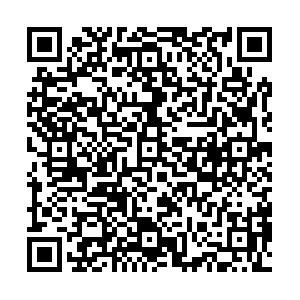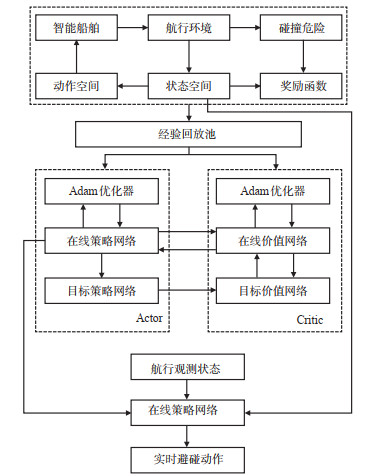A Twin Delayed Deep Deterministic Policy Gradient Method for Collision Avoidance of Autonomous Ships
-
摘要: 为满足智能船舶自主航行的发展需求,解决基于强化学习的船舶避碰决策方法存在的学习效率低、泛化能力弱以及复杂会遇场景下鲁棒性差等问题,针对船舶避碰决策信息的高维性和动作的连续性等特点,考虑决策的合理性和实时性,研究了基于双延迟深度确定性策略梯度(TD3)的船舶自主避碰方法。根据船舶间相对运动信息与碰撞危险信息,从全局角度构建具有连续多时刻目标船信息的状态空间;依据船舶操纵性设计连续决策动作空间;综合考虑目标导向、航向保持、碰撞危险、《1972年国际海上避碰规则》(COLREGs)和良好船艺等因素,设计船舶运动的奖励函数;基于TD3算法,根据状态空间结构,结合长短期记忆(LSTM)网络和一维卷积网络,利用Actor-Critic结构设计船舶自主避碰网络模型,利用双价值网络学习、目标策略平滑以及策略网络延迟更新等方式稳定网络训练,利用跳帧以及批量大小和迭代更新次数动态增大等方式加速网络训练;为解决模型泛化能力弱的问题,提出基于TD3的船舶随机会遇场景训练流程,实现自主避碰模型应用的多场景迁移。运用训练得到的船舶自主避碰模型进行仿真验证,并与改进人工势场(APF)算法进行比较,结果表明:所提方法学习效率高,收敛快速平稳;训练得到的自主避碰模型在2船和多船会遇场景下均能使船舶在安全距离上驶过,并且在复杂会遇场景中比改进APF算法避碰成功率高,避让2~4艘目标船时成功率高达99.233%,5~7艘目标船时成功率97.600%,8~10艘目标船时成功率94.166%;所提方法能有效应对来船的不协调行动,避碰实时性高,决策安全合理,航向变化快速平稳、震荡少、避碰路径光滑,比改进APF方法性能更强。
-
关键词:
- 交通信息工程 /
- 船舶避碰 /
- 智能决策 /
- 深度强化学习 /
- 双延迟深度确定性策略梯度
Abstract: In order to meet the requirements of developingautonomous navigation of intelligent ships and solve the problems of low learning efficiency, weak generalization ability and poor robustness ofdecision-making methods for collision avoidance based on reinforcement learning, an autonomous collision avoidance method based on Twin Delayed Deep Deterministic Policy Gradient(TD3)algorithmis proposed based on the high-dimensional characteristics of the information processed in the process of collision avoidanceand continuity nature of ship maneuvers, also considering the rationality and real-time progress of decision-making. The collision risk of a given ship is calculated by considering geographical location of the ship and the other ships nearby. The state space of intelligent collision avoidance model for autonomous ships is developed from the perspective of the global point of view. The continuous decision-making and action space of the ship is designed according to the maneuvering characteristics of encountered ships. An intelligent collision avoidance model is developed considering factors such as orientation of target ship, course keeping, collision risk, the COLREGs and good seamanship. Based on the TD3 algorithm, the ship autonomous collision avoidance network model is designed based on the state space structure, combining Long Short Term Memory(LSTM)networks and 1D-convolutional networks, and a network model is designed by using Actor-Critic structure.The network training is stabilized by means of clipped double q-learning, target strategy smoothing, and delayed policy updates.The developed collision avoidance model is trained and updated with random scenarios by usingframe skipping, dynamic increase of batch size, and iterative update times.In order to solve the problem of weak generalization ability of the model, a training process of random shipencounter scenariosbased on TD3 is proposed to achievemulti-scenario migration for theapplications of the model. A simulationis carried out to verify the model, then compared with the modified Artificial Potential Field(APF)method. The results show that the proposed method has high learning efficiency, fast and stable convergence. The trained model is applicable for the ships to passa safe distance in both two-ship and multi-ship encounter scenarios. In a complex encounter scenario, the success rate of collision avoidance reaches 99.233% when avoiding 2~4 target ships, 97.600% when 5~7 target ships, 94.166% when 8~10 target ships, is higher than that of the modified APF algorithm. The proposed method can effectively respond to the uncoordinated actions of incoming ships, with real-time performance, as well as safe and reasonable decision-making.The course change is fast, stable, and the vibration is small, also the path for avoiding collisions is smooth, which has better performance than the modified APF method. -
表 1 实验环境信息
Table 1. Experimental environment conditions
硬件环境 处理器(CPU)
显卡(GPU)
内存AMD Ryzen 9 5900X
NVIDIAGeForce RTX 3080Ti 12G
G.Skill 32G/3600Mhz软件环境 操作系统 Windows10(64位) 编程语言 Python 3.9.7 深度学习框架 TensorFlow 2.6.2 强化学习环境 OpenAI Gym 0.19.0 表 2 船舶避碰算法训练参数
Table 2. Training parameters of ship collision avoidance algorithm
参数 数值 参数 数值 迭代次数 1.5x106 折扣因子 0.94 经验池容量 1x106 探索噪声方差 0.5 网络学习率 0.000 3 平滑噪声方差 1 批量大小 128~256 延迟更新频率 4 迭代更新次数 1~2 软更新率 0.005 表 3 多船会遇场景目标船初始设置
Table 3. Initial setting of target ship in multi-ship encounter scenario
船舶 初始位置 航向/(°) 航速/(n mile/h) 目标船(TS1) (7, 0) 315 12 目标船(TS2) (7.5, 7) 225 12 目标船3(TS3) (6, 8) 180 5 目标船4(TS4) (4, 8) 120 4 表 4 对比实验结果数据表
Table 4. Comparison test results data table
实验方法 目标船数量/艘 成功率/% 平均路径长度/n mile TD3
避碰算法2~4 99.233 15.823 5~7 97.600 17.951 8~10 94.166 19.894 改进APF
避碰算法2~4 97.700 14.978 5~7 93.766 16.163 8~10 89.033 17.394 -
[1] 张笛, 赵银祥, 崔一帆, 等. 智能船舶的研究现状可视化分析与发展趋势[J]. 交通信息与安全, 2021, 39(1): 7-16+34. https://www.cnki.com.cn/Article/CJFDTOTAL-JTJS202101003.htmZHANG D, ZHAO Y X, CUN Y F, et al. A visualization analysis and development trend of intelligent ship studies[J]. Journal of Transport Information and Safety, 2021, 39(1): 7-16+34. (in Chinese) https://www.cnki.com.cn/Article/CJFDTOTAL-JTJS202101003.htm [2] LYU H G, YIN Y. COLREGS-constrained real-time path planning for autonomous ships using modified artificial potential fields[J]. The Journal of Navigation, 2019, 72(3): 588-608. doi: 10.1017/S0373463318000796 [3] 黄立文, 李浩宇, 梁宇, 等. 基于操纵过程推演的船舶可变速自动避碰决策方法[J]. 交通信息与安全, 2021, 39(6): 1-10. doi: 10.3963/j.jssn.1674-4861.2021.06.001HUANG L W, LI H Y, LIANG Y, et al. A decision-support system for automated collision avoidance of ships with variable speed based on simulation of maneuvering process[J]. Journal of Transport Information and Safety, 2021, 39(6): 1-10. (in Chinese) doi: 10.3963/j.jssn.1674-4861.2021.06.001 [4] 丁志国, 张新宇, 王程博, 等. 基于驾驶实践的无人船智能避碰决策方法[J]. 中国舰船研究, 2021, 16(1): 96-104+113. https://www.cnki.com.cn/Article/CJFDTOTAL-JCZG202101011.htmDING Z G, ZHANG X Y, WANG C B, et al. Intelligent collision avoidance decision-making method for unmanned ships based on driving practice[J]. Chinese Journal of Ship Research, 2021, 16(1): 96-104+113. (in Chinese) https://www.cnki.com.cn/Article/CJFDTOTAL-JCZG202101011.htm [5] WANG T F, WU Q, ZHANG J F, et al. Autonomous decision-making scheme for multi-ship collision avoidance with iterative observation and inference[J]. Ocean Engineering, 2020(197): 106873. [6] 刘冬冬, 史国友, 李伟峰, 等. 基于最短避碰距离和碰撞危险度的避碰决策支持[J]. 上海海事大学学报, 2018, 39(1): 13-18. https://www.cnki.com.cn/Article/CJFDTOTAL-SHHY201801004.htmLIU D D, SHI G Y, LI W F, et al. Decision support of collision avoidance based on shortest avoidance distance and collision risk[J]. Journal of Shanghai Maritime University, 2018, 39(1): 13-18. (in Chinese) https://www.cnki.com.cn/Article/CJFDTOTAL-SHHY201801004.htm [7] KIM H, KIM S H, JEON M, et al. A study on path optimization method of an unmanned surface vehicle under environmental loads using genetic algorithm[J]. Ocean Engineering, 2017(142): 616-624. [8] ZHANG J F, ZHANG D, YAN X P, et al. A distributed anti-collision decision support formulation in multi-ship encounter situations under COLREGs[J]. Ocean Engineering, 2015 (105): 336-348. [9] 朱凯歌, 史国友, 刘娇, 等. 基于船舶领域的让路船决策分析[J]. 上海海事大学学报, 2019, 40(3): 26-31. https://www.cnki.com.cn/Article/CJFDTOTAL-SHHY201903006.htmZHU K G, SHI G Y, LIU J, et al. Analysis on decision-making of give-way ships based on ship domain[J]. Journal of Shanghai Maritime University, 2019, 40(3): 26-31. (in Chinese) https://www.cnki.com.cn/Article/CJFDTOTAL-SHHY201903006.htm [10] KANG Y T, CHEN W J, ZHU D Q, et al. Collision avoidance path planning in multi-ship encounter situations[J]. Journal of Marine Science and Technology, 2021, 26(4): 1026-1037. doi: 10.1007/s00773-021-00796-z [11] MNIH V, KAVUKCUOGLU K, SILVER D, et al. Human-level control through deep reinforcement learning[J]. Nature, 2015, 518(7540): 529-533. doi: 10.1038/nature14236 [12] CHENG Y, ZHANG W D. Concise deep reinforcement learning obstacle avoidance for underactuated unmanned marine vessels[J]. Neurocomputing, 2018(272): 63-73. [13] 王程博, 张新宇, 邹志强, 等. 基于Q-Learning的无人驾驶船舶路径规划[J]. 船海工程, 2018, 47(5): 168-171. https://www.cnki.com.cn/Article/CJFDTOTAL-WHZC201805038.htmWANG C B, ZHANG X Y, ZOU Z Q, et al. On path planning of unmanned ship based on Q-Learning[J]. Ship & Ocean Engineering, 2018, 47(5): 168-171. (in Chinese) https://www.cnki.com.cn/Article/CJFDTOTAL-WHZC201805038.htm [14] 周怡, 袁传平, 谢海成, 等. 基于DDPG算法的游船航行避碰路径规划[J]. 中国舰船研究, 2021, 16(6): 19-26, 60. https://www.cnki.com.cn/Article/CJFDTOTAL-JCZG202106003.htmZHOU Y, YUAN C P, XIE H C, et al. Collision avoidance path planning of tourist ship based on DDPG algorithm[J]. Chinese Journal of Ship Research, 2021, 16(6): 19-26, 60. (in Chinese) https://www.cnki.com.cn/Article/CJFDTOTAL-JCZG202106003.htm [15] ZHAO L M, ROH M I, LEE S J. Control method for path following and collision avoidance of autonomous ship based on deep reinforcement learning[J]. Journal of Marine Science and Technology, 2019, 27(4): 293-310. [16] ZHAO L, ROH M I. COLREGs-compliant multiship collision avoidance based on deep reinforcement learning[J]. Ocean Engineering, 2019(191): 106436. [17] XIE S, CHU X M, ZHENG M, et al. A composite learning method for multi-ship collision avoidance based on reinforcement learning and inverse control[J]. Neurocomputing, 2020 (411): 375-392. [18] 周双林, 杨星, 刘克中, 等. 规则约束下基于深度强化学习的船舶避碰方法[J]. 中国航海, 2020, 43(3): 27-32+46. https://www.cnki.com.cn/Article/CJFDTOTAL-ZGHH202003005.htmZHOU S L, YANG X, LIU K Z, et al. COLREGs-compliant method for ship collision avoidance based on deep reinforcement learning[J]. Navigation of China, 2020, 43(3): 27-32+46. (in Chinese) https://www.cnki.com.cn/Article/CJFDTOTAL-ZGHH202003005.htm [19] SHEN H Q, HASHIMOTO H, MATSUDA A, et al. Automatic collision avoidance of multiple ships based on deep Q-learning[J]. Applied Ocean Research, 2019(86): 268-288. [20] SAWADA R, SATO K, MAJIMA T. Automatic ship collision avoidance using deep reinforcement learning with LSTM in continuous action spaces[J]. Journal of Marine Science and Technology, 2021, 26(2): 509-524. [21] CHUN D H, ROH M I, LEE H W, et al. Deep reinforcement learning-based collision avoidance for an autonomous ship[J]. Ocean Engineering, 2021(234): 109216. [22] VAGALE A, OUCHEIKH R, BYE R T, et al. Path planning and collision avoidance for autonomous surface vehicles I: A review[J]. Journal of Marine Science and Technology, 2021 (26): 1292-1306. [23] AKDAG M, SOLNOR P, JOHANSEN T A. Collaborative collision avoidance for maritime autonomous surface ships: A review[J]. Ocean Engineering, 2022(250): 110920. [24] SINGH B, KUMAR R, SINGH V P. Reinforcement learning in robotic applications: a comprehensive survey[J]. Artificial Intelligence Review, 2021(55): 945-990. [25] FUJIMOTO S, HOOF H, MEGER D. Addressing function approximation error in actor-critic methods[J]. Proceedings of Machine Learning Research, 2018(80): 1587-1596. [26] NGUYEN T T, NGUYEN N D, NAHAVANDI S. Deep reinforcement learning for multiagent systems: A review of challenges, solutions, and applications[J]. IEEE Transactions on Cybernetics, 2020, 50(9): 3826-3839. -





 下载:
下载:






















